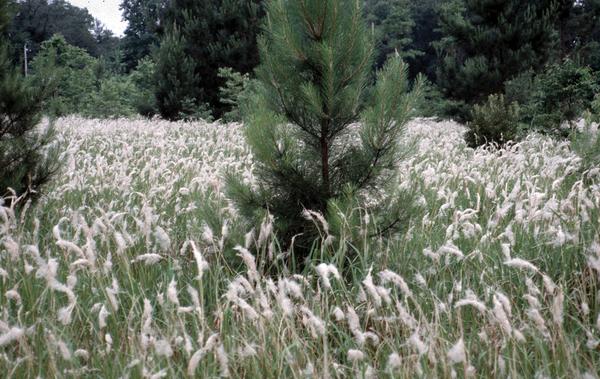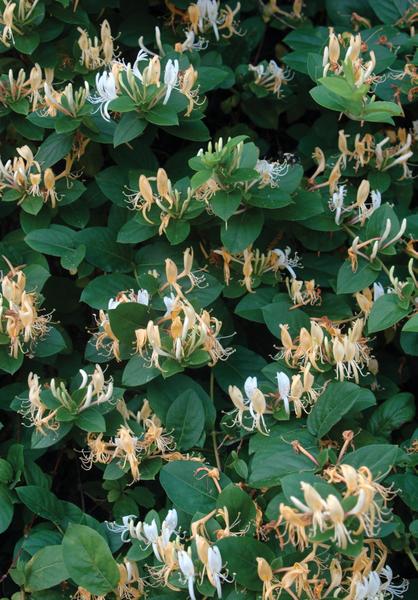Non-native plants are referred to by many names: exotic, nonindigenous, alien, or even noxious weeds. Non-native plant species become invasive when they spread and reproduce beyond their area of origin, aggressively dominate or cause harm in a new area. Common examples from southeast forests include kudzu (Figure 1), cogongrass (Figure 2), and Japanese honeysuckle (Figure 3).
Invasive plants are present on 1 out of every 10 southern forest acres, a staggering 19 million acres. Invasive plants are likely to double their extent in the next 50 years as the climate becomes more variable. This note explores the impacts and possible control measures for invasive plants in forestlands.
Invasive Plant Concerns
Southern forests are unique and diverse—they provide critical wildlife habitat, preserve our cultural heritage, and supply the globe with timber and fiber products. Invasive plants degrade and threaten the integrity and native composition of forest ecosystems. They can increase tree seedling mortality, inhibit regeneration, and reduce growth in timber plantations. Invasive plants reduce wildlife habitat diversity and quality even at low densities. Some invasives may increase wildfire risk, change soil chemistry, or impact natural hydrology. Invasive plant species also negatively impact forest health, biodiversity, ecosystem services, and profitable or commercial use. A study published by the US Fish and Wildlife Service in 2012 estimated $120 billion in annual economic losses from invasive plants in the United States. Even excluding further expansion of invasives, their impact equates to more than $157 billion in today’s dollars.
Non-Native Plants Can Invade
Non-native plants come in all forms, including trees, shrubs, vines, grasses, and ferns. Invasive, non-native plants are aggressive survivalists and share these tendencies:
- Grow vigorously
- Survive in a range of conditions
- Reproduce quickly
- Difficult to eradicate
According to the Center for Invasive Species and Ecosystem Health, there are over 1,500 non-native, invasive plants in the United States.
How Do Non-Natives Get Here?
Non-native plants occur here as a result of direct or indirect, deliberate or accidental actions by humans. This publication focuses on the invasive, non-native plants which, like kudzu or Japanese honeysuckle, survive and reproduce without human intervention.
Most non-native plant species are introduced intentionally from other countries by people with good intentions. They are often used to improve wildlife habitat, stabilize or prevent soil erosion, beautify yards and homes, provide recreational opportunities like hunting or fishing, or for many other reasons (Table 1).
| Plant | Country of Origin | Purpose |
|---|---|---|
| Chinese silvergrass | Asia | Ornamental / Horticulture |
| Oriental bittersweet | Asia | Ornamental / Horticulture |
| Autumn olive | China | Wildlife habitat / Ornamental |
| Bicolor lespedeza | Japan | Wildlife habitat / Ornamental |
| Kudzu | Asia | Erosion control/ Forage |
| Sericea lespedeza | Asia | Erosion control/ Forage |
| Chinaberry | India, Pakistan, western China | Ornamental |
| Paulownia / princess tree | China | Ornamental and wood product |
Non-native species not introduced into the United States intentionally have hitched a ride here via packing material, hurricanes, untreated soil or wood samples, and potentially within the digestive tracks of migratory or imported animal species.
How Do Non-Native Plants Invade?
Invasive plants are extremely productive. They can grow and reproduce rapidly, can breed or reproduce at early ages, have longer growing seasons which means faster growth to maturity, and can reproduce via multiple pathways (via roots, stems, or seeds). Some non-native plants produce hundreds of thousands of seeds that can persist in the soil for many years until disturbed.
Many of the non-native, invasive plants have long seed viability (that is, high dormancy rates), multiple adaptations for seed dispersal, and high or staggered germination rates. Japanese stiltgrass can produce 100 to 1,000 seeds per plant that can remain viable in the soil for at least 7 to 10 years and are transported easily with water or on animal fur and human clothing.
What Adaptations Make Them Succeed?
Some invasive plants, such as tree-of-heaven, have allelopathic properties and can release chemicals into the soil that inhibit the growth of or kill surrounding plants. Non-native, invasive plants also compete aggressively for resources, such as food, water, nesting sites, and cover, and can tolerate a wide variety of environmental conditions. Many have salinity, drought, shade, or flooding tolerances; can handle high sedimentation, high nutrient load waters; and can handle extremely cold or hot weather. They can also adapt easily and expand their range quickly. Most non-native, invasive plants lack natural pest control from their native environment and may be resistant to native predators. Many non-native plants may share one, if not several, of these invasive characteristics.
Invasive Plants Impact Forest Ecosystems
Invasive plants can impact forest ecosystems and biodiversity in a variety of ways:
- Reduce forest health and timber productivity. Invasive plant competition, introduced diseases, and insect infestations in forestland can cause increased seedling mortality or cause problems with natural regeneration of forests. Allelopathic plants (plants that use chemicals to reduce competition) or competitive vines, such as Chinese wisteria and morning glory, can reduce seedling survival and crop tree growth rates.
- Impact ecosystem processes. Invasive plants can change disturbance regimes, hydrology, geomorphology, and soil chemistry.
- Cogongrass, for example, can increase fire intensity in ecosystems that are adapted to frequent, low intensity fires, which can result in a decrease in native and/or rare plants associated with such ecosystems.
- Chinese tallow tree and barberry can increase soil pH and nutrient loads in soil.
- Russian olive and Spartina can change natural hydrology.
- Displace native plants. Displacement is the most common community level impact from invasive plants.
- Japanese knotweed, for example, can alter organic matter decomposition and soil chemistry to favor itself competitively.
- Japanese stiltgrass out-competes native herbs, and porcelainberry and kudzu shade out native plants.
- Autumn olive can completely shade out the understory of a forest, reducing the herb layer that is consumed by eastern box turtles and other ground-dwelling wildlife.
- Affect wildlife habitat and populations. Bush honeysuckle and buckthorn are favored by birds because of their strong branches, but the shrubs also ease predator access which can result in reduced nest success.
- Many birds prefer non-native fruits and are attracted to the showy flowers and colorful berries, which only aids in the plant’s dispersal and can alter the foraging activity of birds.
- Changes in fruit availability and nutrition can also have direct impacts on the health of wildlife populations. Native insects are closely linked to native plant species diversity. When non-native, invasive plants displace native plants, they also eliminate their supporting insect abundance or distribution and the insectivores that control pest insects. Ultimately, a decline in pollination services by native insects can alter the human food supply.
- Nandina is toxic to birds, which causes mass die offs.
- Reduce biodiversity. Non-native, invasive plants can drastically reduce biodiversity of native plants, which in turn can reduce biodiversity of wildlife by changing the structure and composition of vegetation communities. This can lead to a decline in endangered, threatened, special concern or rare species or plant communities. “Approximately 42% of threatened or endangered species are at risk due to non-native, invasive species” in Ecological Economics article in 2005.”
Some of the more common and problematic non-native, invasive plants found in North Carolina are listed below:
Trees: tree-of-heaven, princess tree, chinaberry, mimosa, Chinese tallow
Vines: kudzu, Chinese wisteria, Japanese honeysuckle, Oriental bittersweet, English ivy, and periwinkle
Shrubs: Chinese privet, nandina, autumn olive, multiflora rose, Russian olive, bicolor lespedeza (shrub lespedeza or VA-70)
Grasses: Japanese stilt grass, Chinese silvergrass, tall fescue, bamboo, Johnsongrass, Bermuda grass, bahiagrass, weeping lovegrass
Aquatic: alligatorweed, hydrilla, Japanese knotweed, purple loosestrife, parrot feather milfoil, giant salvinia
Herbs/forbs: sericea lespedeza, garlic mustard, bull thistle
Invasive Plant Management
Plan to take the following precautions to manage invasive plants:
- Prevent entry and spread
- Map invasive plant locations
- Eradicate, control, or contain then monitor (and repeat)
- Rehabilitate, restore, or reclaim treated lands
Choose control methods that work:
- Chemical methods (herbicides)
- Manual methods (hand removal)
- Mechanical methods
- Cultural methods (prescribed burning, flooding, planting, and seeding)
- Biological control methods (grazing, targeted bio-control agents for insects and pathogens)
- Mulching and solarization methods
Summary
Our best defense against invasive species is to prevent their introduction. Our next strategy is to eradicate or reduce the spread of the invasive, non-native species already here. So, take the following actions to help:
- Know thy enemy. Learn the most prevalent non-native, invasive species in your area. Know how to identify them, report infestations to your local conservation agency, and tell your friends and family about the negative effects of non-native, invasive species.
- Do not collect invasive plants, their seeds, or reproductive bodies. Do not purchase or transport materials containing non-native, invasive species.
- Landscape with native plants. Request native plants at your local plant nursery if they do not currently sell them.
- Minimize disturbed ground. Avoid driving or recreating in areas where non-native, invasive plants grow. Clean boats/trailers, vehicle undercarriages, boots, and equipment, removing all plant material and mud. Brush dogs before leaving the site. Empty all live wells and bait buckets on-site.
- Control or eradicate invasive, non-natives on your property. Visit the following websites for specific recommendations for chemically or mechanically controlling invasive plants:
- Monitor your property annually. Learn effective management practices, and treat the non-native, invasive plants quickly before they become established.
- Be persistent. You will most likely need multiple chemical or mechanical treatments for invasive plants. Start with the mature, fruiting plants first, then attack the immature, non-fruiting plants. Be persistent and get help.
- Be conscious when moving livestock around on your property, because seeds will travel in their digestive systems. Comb pet fur after hiking in areas where non-native, invasive plants are common.
- Report invasive plant infestations to your local land management agency or one of the following agencies:
Resources
Identify
Miller, James H., Chambill, Erwin B., Loewenstein, Nancy, J. 2010. “A Field Guide for the Identification of Invasive Plants in Southern Forests”
Control
Miller, James H., Manning, Steven T., Enloe, Stephen F. 2010. “A Management Guide for Invasive Plants in Southern Forests”
Natives
Moorman, C., M. Johns, L. T. Bowen, et al. 2017. Landscaping for Wildlife with Native Plants. AG-636-3. NC State Extension
Tallamy, Doulas W. 2009. “Bringing Nature Home: How You Can Sustain Wildlife with Native Plants”
U.S. Fish and Wildlife Service. 2012. Cost of Invasive Species.
Publication date: Nov. 25, 2019
Reviewed/Revised: Sept. 11, 2024
AG-771
N.C. Cooperative Extension prohibits discrimination and harassment regardless of age, color, disability, family and marital status, gender identity, national origin, political beliefs, race, religion, sex (including pregnancy), sexual orientation and veteran status.



